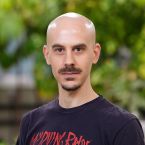Shaul Pollak

Shaul Pollak is tackling an extremely complex topic in his research project. In our interview, Shaul Pollak gives an insight into his work, describes how the idea for this project came about and who the results of the project will help most in the future.
In 5 sentences, or less, please describe the project.
The functioning of virtually all ecosystems on earth depends on microbiome functions and imagining a world without microbes is imagining a world quickly sinking into desolation and decay. Microbiomes are extremely complex, much more than any animal ecosystem, with billions upon billions of individuals belonging to thousands of different species. The most widely used technology to study microbiomes is DNA sequencing, but most DNA is still undecipherable to us, severely limiting our understanding of the functioning of these important communities. Our project will develop AI-powered tools that transform extremely complex microbiome DNA sequence data into simple “functional groups” that represent microbes that perform similar functions in the community. We will then determine the quantitative effect that interactions between “functional groups” have on community function, and how climate-change modulates these effects, culminating in a general quantitative theory that is applicable across different ecosystems.
When and where was the idea of the project born?
During my postdoc at MIT in Boston, Massachusetts me and my wife would go every weekend to wander in the forests of New England (Hampshire, Maine, Vermont, and Massachusetts). While we were hiking, we would talk about the different plants and animals that we saw, and how interactions between them made the landscape the way it is. This led to very naïve but also deep conversations about ecology, interactions, and what matters for ecosystem function from an ecological perspective. Because my wife is not a scientist, I would always try to find ways to explain complicated concepts in simple terms. At the time, my main research focus was on marine microbiomes, and these conversations with my wife sparked my interest in the much more complex terrestrial microbiomes, exposing the need to simplify them in order to understand them and create quantitative models of their function that are general across many different ecosystems. The ideas for the project flowed naturally from my previous obsession with ecology, complex system science, machine-learning, genomics, and microbiology… or put simply, with science.
What would be the ideal outcome of your project for you?
I think that it is increasingly understood that to confront the existential issues facing humanity, including climate change and food security for example, a multitude of technological, scientific, and social changes must coalesce. The importance of microbial processes for this vision cannot be overstated, yet they are probably the hardest to control, predict, and manipulate because we understand so little about microbiomes. In an ideal world, our project would reveal conserved “design principles” of bacterial genomes and of microbiomes that degrade polymeric sugars, which is a central activity of microbes in the land, sea, and even in human guts. This means that there is real hope to find general principles that could then be applied to many different natural and applied systems, eventually leading to diverse applications.
Who will the output of your project help most in the future?
My research deals with basic science – ecology, genomics, microbiology, etc. I hope that people in the scientific community, which is quite tribal in the sense that people from different disciplines rarely talk to each other, would be the primary beneficiaries of this work and that it would bring people from different fields and disciplines together. In the more distant future I hope, and very realistically aim for our insights to be incorporated into climate models (which depend very strongly on microbial activity), and in developing personalized “ecology-based” probiotics for humans, animals, and agriculture.
